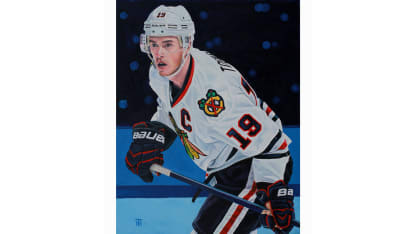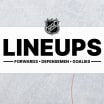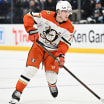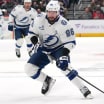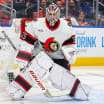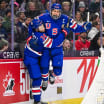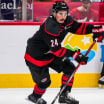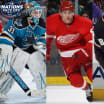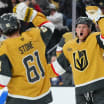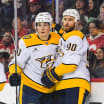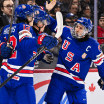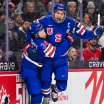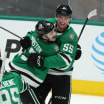As part of the NHL Centennial Celebration, renowned Canadian artist Tony Harris will paint original portraits of each of the 100 Greatest NHL Players presented by Molson Canadian as chosen by a Blue Ribbon panel. NHL.com will reveal two portraits each Monday in 2017.
This week, the portraits of centers Jean Ratelle and Jonathan Toews are unveiled in the 41st installment.
Ratelle, Toews portraits unveiled
Color paintings of 100 Greatest NHL Players will be revealed on NHL.com every Monday in 2017
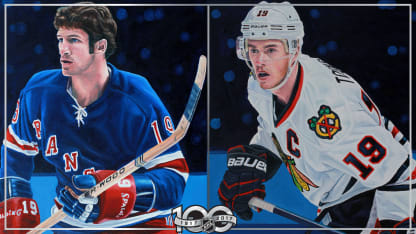
By
NHL.com @NHLdotcom
In the rock 'n' roll world of the NHL in the 1960s and '70s, Jean Ratelle was smooth jazz.
While others darted around the rink with choppy strides as they chased the puck, Ratelle glided, tall, swift and elegant, usually getting there ahead of them with what seemed to be minimal effort. He drew comparisons to his boyhood hero, Jean Beliveau of the Montreal Canadiens, who said of Ratelle: "He's so unselfish, always feeding passes to his two wingers."
Rod Gilbert was one of those wingers for most of Ratelle's amateur and pro career. The two became schoolmates and teammates when Ratelle's father, Leo, moved the family to Montreal when he was 10. When Gilbert was 16, he landed with the Rangers' Junior A team in Guelph, Ontario, then told the coaches and scouts to get Ratelle because "he's better than me."
Gilbert and Ratelle went on to become two-thirds of one of the great lines in Rangers history, the "GAG Line," and powered them to the Semifinals in 1971 and the Stanley Cup Final a year later -- though Ratelle's quest for the scoring title in 1971-72 ended on March 1 when a slap shot from teammate Dale Rolfe broke a bone above his right ankle. Ratelle made it back for the Final but was far less than 100 percent during the Boston Bruins' six-game victory.
Ratelle joined the Bruins three years later when he and defenseman Brad Park were sent to Boston for center Phil Esposito and defenseman Carol Vadnais in one of the biggest trades in NHL history. Ratelle continued to excel in Boston, helping the Bruins advance to the Final in 1977 and '78. He retired in 1980 as the No. 6 scorer in NHL history with 1,267 points (491 goals, 776 assists), having never taken a major penalty in 21 seasons. The Rangers will retire his No. 19 on Feb. 25.
In his
NHL100 profile of Ratelle
, author Stu Hackel wrote about his quiet brilliance:
"Quiet, modest and unassuming, Ratelle's gentlemanly play earned him the Lady Byng Trophy twice, and he was among the top five vote-getters for the award another six times. The media called him 'Gentleman Jean' for good reason.
"His teammates, however, called him 'Ratty,' and they held him in their highest regard. Rangers defenseman Brad Park, who was traded with Ratelle to Boston in 1975, called him "our straight arrow." He told [writer Stan] Fischler, 'Ratty is without a doubt the model hockey player, totally dedicated to the sport and the team. He plays hockey according to the rule book and would never think of elbowing or smashing a guy or doing anything physical. He's just a beautiful hockey player.'"
"That esteem reached its zenith in 1971-72 when the NHL Players' Association selected Ratelle the winner of the Lester B. Pearson Award (now the Ted Lindsay Award) as the League's top performer, revealing the extent of the admiration he had won.
"In that season, Ratelle led the scoring race at the midway point, ahead of Phil Esposito and Bobby Orr. On Feb. 20, 1972 against the Detroit Red Wings, Ratelle scored his 42nd goal to become the first NHL player that season to reach 100 points -- and the first Rangers player in history to hit the mark. The fans at Madison Square Garden gave him one of the loudest, longest standing ovations in Rangers history.
"'Ratelle briefly and modestly acknowledged the cascading applause and, looking embarrassed, skated back to the bench,' Fischler wrote. He'd add another goal and assist that night."
Artist Tony Harris said he was most intrigued by a unique element of Ratelle's equipment.
"One of the fun aspects of painting Jean Ratelle's portrait was his hockey gloves," he said. "They were made by Spalding and called Fastbacks. A few lucky kids had them when I was playing minor hockey, and we thought they were really cool. Who knows, maybe they will make a comeback."
As Ratelle did with the Rangers, Jonathan Toews wears No. 19 with the Chicago Blackhawks. Though he may not finish with the offensive numbers that Ratelle put up, Toews already has three Stanley Cup championships, two Olympic gold medals, a Conn Smythe Trophy and a Selke Trophy as the NHL's top defensive forward. He's already the longest-serving captain in Blackhawks history -- and he's not even 30.
Toews became captain before the 2008-09 season, his second with the Blackhawks. He had played all of 64 NHL games. No one in League history had been named captain faster.
His businesslike manner earned Toews the nickname "Captain Serious." But it also showed that he's the kind of player who never takes a night off and sets the kind of example that winning teams feed off. Toews doesn't put up the kind of offensive numbers that longtime teammate Patrick Kane does, but his defensive skills, leadership and willing to do a lot of the grunt work that turn teams into champions are a big reason the Blackhawks are enjoying the greatest decade in their history.
In the words of Mike Babcock, who coached him with Canada in the 2010 and 2014 Winter Olympics and against him with the Detroit Red Wings and now with the Toronto Maple Leafs, "All Jonathan Toews does is make everybody he plays with better."
In his NHL100 profile of Toews, author Bob Verdi wrote about his impact on the Blackhawks:
"Entering the 2006 NHL Draft, the Blackhawks were in dire need of new blood and a new direction. They had qualified for the playoffs once since 1997, making an abrupt five-game exit in 2002, and fan interest had dipped precipitously throughout an Original Six market. In the words of no less an authority than chairman Rocky Wirtz, 'We had become irrelevant.'
"The Blackhawks could not afford to miss on the No. 3 pick. They knew of Toews' decorated amateur career, first at Shattuck-St. Mary's School in Minnesota, then at the University of North Dakota. They probably anticipated that his pedigree -- in 2007 he would become the first Canadian to win gold at the World Junior Championship and World Championship in the same year, and did it as a second-year collegian -- would bode well for his evolution as a professional on hockey's greatest stage, the NHL. They might even have heard the story about how, when Jonathan was a tyke, he made a promise.
"'He told me he was not only going to make it in the NHL,' said his father, Bryan. 'He told me he was going to make it big and buy me a new truck.'
"The Blackhawks did not miss. They studied the person and the statistics, but there was no guarantee that Jonathan Toews would point the franchise toward a golden era with his excellence and maturity. He made a quick impression, scoring on his first shot with the Blackhawks, against the San Jose Sharks on Oct. 10, 2007, and got a point in each of his first 10 games, then the second-best streak by any player to start an NHL career. Toews had 24 goals and 30 assists in 2007-08, his rookie season in Chicago, but it was more than that. It was his presence, the example he set, on the ice, in the locker room, on the bus."
Harris likens Toews to a member of the 100 Greatest NHL Players who ended his career just before Toews arrived in Chicago.
"It is always more rewarding when you truly admire a subject that you are painting," he said. "Jonathan Toews is one of those subjects. He is the modern-day Steve Yzerman and continues to set a very high bar for young NHL stars."
Jean Ratelle
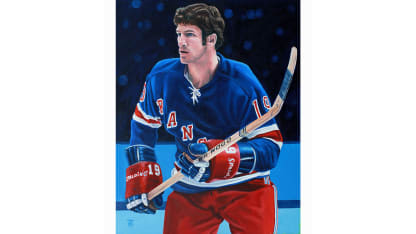
Jonathan Toews
